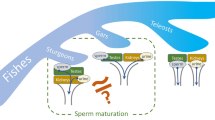Summary
The epididymis of the cock is divided into a main part and an appendix epididymidis.
The main part of the epididymis is firmly connected to the testis. The sperm transporting tubes open into the ductus epididymidis along its entire length. The rete testis, as the most proximal part of the epididymis, develops from mesenchym cells. The rete testis connects the tubuli seminiferi with the ductuli efferentes proximales which develop from the Bowman's capsules of the mesonephros. The ductuli efferentes distales develop from the proximal tubules, conducting segments (loops of Henle), and the distal tubules of the mesonephros. The short ductuli conjugentes which open into the ductus epididymidis, originate from the connecting segments of the mesonephros.
In the sexually mature cock the rete testis, the ductuli efferentes proximales, and the ductus epididymidis all show an enlargement in the lumen. In the ductuli efferentes proximales and in the ductus epididymidis one can observe a formation of globuli and cell protrusion which lead to a loss of the surface structure of the epithelial cells.
The appendix epididymidis and the capsula fibrosa of the adrenal gland are joined by connective tissue. The appendix epididymidis consists of the blindly ending ductus aberrans (the cranial continuation of the ductus epididymidis) and the ductuli aberrantes which open into the ductus aberrans. The blind ends of the ductuli aberrantes end in the capsula fibrosa of the adrenal gland.
Similar content being viewed by others
References
Alverdes, K.: Der Nebenhoden des Haussperlings. Z. mikr.-anat. Forsch. 1 207–227 (1924)
Budras, K.-D.: Das Epoophoron der Henne und die Transformation seiner Epithelzellen in Interrenal- und Interstitialzellen. Ergebn. Anat. Entwickl.-Gesch. 46/3, 1–70 (1972)
Fawcett, D. W., Hamilton D. W.: Electron microscopical and biochemical evidence for steroid biosynthesis by the mammalian Epididymis and Vas deferens. Morph. aspects of Andrology 1, 119–121 (1970)
Fawcett, D. W., Heidger, P. M., Leak, L. V.: Lymph vascular system of the interstitial tissue of the testis as revealed by electron microscopy. J. Reprod. Fertil. 19, 109–119 (1969)
Firket, J.: Recherches sur l'organogenèse des glandes sexuelles des oiseaux. Anat. Anz. 46, 413–425 (1914)
Gier, H. T., Marion, G. B.: Development of mammalian testes and genital ducts. Biol. Reprod. 1, 1–23 (1969)
Gray, J. G.: The anatomy of the male genital ducts in the fowl. J. Morph. 60, 394–405 (1936/37)
Hamilton H. L.: Lillie's development of the chick. New York: Holt & Co. 1952
Holstein, A. F.: Morphologische Studien am Nebenhoden des Menschen. Stuttgart: Thieme 1969
Kumerloeve, H.: Das Urogenitalsystem (Niere und Geschlechtsapparat) der Vögel. Veröff. Naturw. Vereins Osnabrück 27, 86–134 (1954)
Knouff, R. A., Hartmann, F. A.: A microscopic study of the adrenal gland of the Brown Pelican. Anat. Rec. 109, 161–189 (1951)
Lake, P. E.: The male reproductive tract of the fowl. J. Anat. (Lond.) 91, 116–133 (1957)
Marvan, F.: Postnatal development of the male genital tract of the Gallus domesticus. Anat. Anz. 124, 443–462 (1969)
Morgagni, J. B.: Adveraria anatomica omnia Batavia. Advers. 4 (Animadvers. 29), J. A. Langerak, Lugduni Batavorum (1723)
Nicander, L.: On the morphological evidence of secretion and absorption in the epididymis. Morph. aspects of Andrology 1, 121–124 (1970)
Remmers, J.: Lichtmikroskopische Untersuchungen am Hoden, Nebenhoden und Samenleiter des Hahnes (Gallus gallus domesticus L.) Diss. vet. med. Hannover 1973
Roosen-Runge, E. C.: The Rete testis in the albino rat: Its structure, development and morphological significance. Acta anat. (Basel) 45, 1–30 (1961)
Sauer, T.: Genese und Struktur des Nebenhodens einschließlich Rete testis beim Haushahn (Gallus domesticus). Diss. vet. med. FU Berlin 1974
Schwarze, E., Schröder, L.: Kompendium der Geflügelanatomie. Stuttgart: Fischer 1968
Stampfli, R.: Histologische Studien am Wolffschen Körper (Mesonephros) der Vögel und über seinen Umbau zu Nebenhoden und Nebenovar. Rev. suisse Zool. 57, 237–316 (1950)
Starck, D.: Embryologie. Stuttgart: Thieme 1965
Stieve, H.: Harn-und Geschlechtsapparat. 2. Teil. Männliche Genitalorgane. In: Möllendorff, W. v., Handbuch der mikroskopischen Anatomie des Menschen. Berlin: Springer 1930
Stoll, R., Maraud, R.: Sur la constitution de l'epididyme du coq. Evolution des canaux mésonéphrétiques. C. R. Soc. Biol. (Paris) 149, 687–689 (1955a)
Stoll, R., Maraud, R.: Action de la testostérone sur la morphogenese de l'epididyme du coq: Les connexions de l'ebauche épididymaire avec le rete testis. C. R. Soc. Biol. (Paris) 149, 370–372 (1955b)
Tannenberg, G. G.: Abhandlung über die männlichen Zeugungstheile der Vögel. Göttingen: Dieterich 1810
Tingary, M. D.: On the structure of the epididymal region and ductus deferens of the domestic fowl (Gallus domesticus). J. Anat. (Lond.) 109, 423–435 (1971)
Tingary M. D.: The fine structure of the epithelial lining of the excurrent duct system of the testis of the domestic fowl (Gallus domesticus). Quart. J. exp. Physiol. 57, 271–295 (1972)
Tingary, M. D.: Histochemical localization of 3-β and 17-β-Hydroxysteroid-dehydrogenase in the male reproductive tract of the domestic fowl (Gallus domesticus). Histochem. 5, 57–65 (1973)
Traciuc, E.: La structure de l'épididyme de Coloens monedula (Dohle) [Aves,Cornidae]. Anat. Anz. 125, 49–67 (1969)
Unsicker, K.: Fine structure and Innervation of the Avian Adrenal Gland. I. Fine structure of Adrenal Chromaffin Cells and Ganglion Cells. Z. Zellforsch. 145, 380–416 (1973)
Venable, J. H., Coggeshall, R.: A simplified lead citrate stain for use in electron microscopy. J. Cell Biol. 25, 407 (1968)
Venske, W. G.: The morphogenesis of the Testes of chicken embryos. Amer. J. vet. Res. 56, 450–456 (1954)
Wendler, D.: Der histochemische Aktivitätswandel des proximalen Urnierennephros während der Entwicklung des Hühnchens. Z. Anat. Entwickl.-Gesch. 124, 478–503 (1965)
Wrobel, K.-H.: Zur Morphologie der Ductuli efferentes des Bullen. Z. Zellforsch. 135, 129–148 (1972)
Author information
Authors and Affiliations
Rights and permissions
About this article
Cite this article
Budras, K.D., Sauer, T. Morphology of the epididymis of the cock (Gallus domesticus) and its effect upon the steroid sex hormone synthesis. Anat. Embryol. 148, 175–196 (1975). https://doi.org/10.1007/BF00315268
Received:
Issue Date:
DOI: https://doi.org/10.1007/BF00315268




